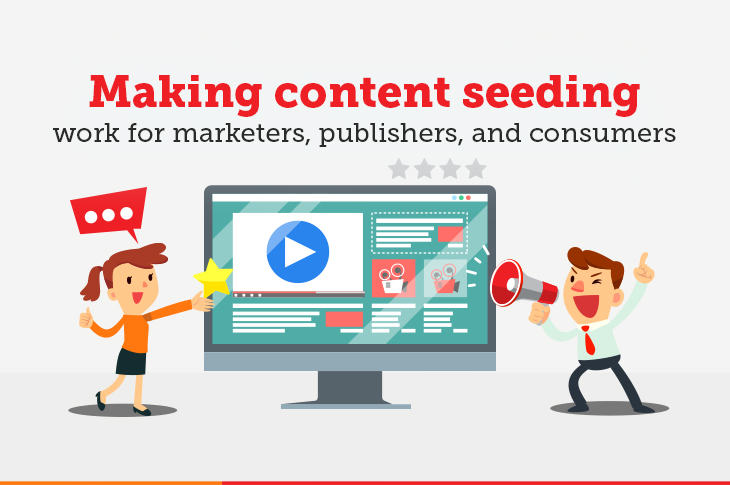The art of content seeding for better content marketing engagement

In July 2013, Netflix aired the first episode of its popular series, ‘Orange Is the New Black’. Very broadly, the series is about women inmates, correctional officers, and their experiences. As with many Netflix serials, their marketing team went all out to promote the series. Chances are, even if you did not watch the series, you’re likely to have heard of it.
And why not? Netflix painted almost everything orange and ran a multimedia advertising and marketing blitz. One of the most exciting marketing initiatives was a ‘paid post’ in the New York Times. This paid post (you could not mistake it for editorial content – not with the BIG Netflix logo alluding to the sponsorship) was filled with graphics, videos, images, and text.
The story was about the lives of real-world women in federal prisons in the US and how the male model of incarceration does not work for women inmates. If it were not for the ‘paid post’ mention, you could be forgiven for thinking this was the mainline editorial. Unlike most other sponsored content, it showed the real power of context and content marketing.
This effort created what is arguably still the best content marketing example of content seeding. According to Professor Mike McKean from the Missouri School of Journalism, “The likelihood of clicking away before you scroll down and read much content is a lot higher than the average piece of native content. This [paid post] is not average.”
Building a muscle
As banner advertising sees less efficiency and revenue yields, several publishers are discovering the power of native offerings. It’s a far cry from the past where an ‘advertorial’ was the bastard child delegated to the recently joined intern in the editorial team. But it’s still many miles away from unlocking its real potential.
Of course, not every piece of content can offer the content width that Netflix and The New York Times could. But can’t we tell stories a lot better than we are doing today? Can’t publishers add more teeth and power to their ad sales or branded content sales teams? Can’t marketers look beyond the cursory reach offered by a media agency? If you don’t, the reader won’t care too much, and the marketer’s or publisher’s success will be limited to presentations made to peers and the management.
How do we make content seeding move up a notch and contribute to overall content marketing success? There are at least three, if not four, partners involved in driving this aspect of content marketing success. They are the publisher, the marketer, the media agency, and the content marketing agency. The media agency will typically stop at buying the best content marketing real estate and an optimal cost. Their planning team will draw a consideration set of publishers and influencers.
Usually, their engagement ends right there. I’m going to focus on two other partners – namely, the publisher and the marketer.

Content Seeding for Publishers
(a) Invest in building a robust content marketing team. The management needs to focus on getting the right talent and back them with great tools to make sponsored content a success. You have to move away from the past when you just hired great media salespersons and let them carry the load. Your branded content editorial team needs to be an integral part of the mainline editorial team meetings and feel as if they belong there. If not, think of them as the editorial team that works on features-led content. That will help them stay within the tone and tenor of the material that you, as a publisher, offers the reader.
(b) Your branded content team’s responsibility is to drive value for the marketer. In this lies your future business and revenue success. It would be best if you told the marketer story well too. Understand and invest time in knowing what the marketer needs to communicate. Then match that with how you would otherwise tell your readers their story.
(c) Make your content discoverable and spend time on where it will get the best traction. I’m not even remotely suggesting that you headline this content, but it’s unfair to the marketer if the content hides deep within the website, and you buy your way to achieve ‘reach goals’. Your analytics team needs to be actively involved in driving this effort.

Content Seeding for Marketers
(a) Look beyond the media reach. That worked well for advertising. I’m not saying you should discount reach, but you can achieve ‘reach goals’ through several permutations and combinations. The choice of media has never been better. Leverage this choice at your disposal. Understand the publisher’s editorial environment and user behavior. You have a story to tell, but the publisher has a way of telling a story. That gap needs to be bridged. Good content marketing is about addressing your customers’ pain points. Please do not treat this as traditional PR. Those days are gone.
(b) Don’t be allergic if your content carries a ‘paid post’ or ‘sponsored content’ tag. Consumers understand you are in business, and that you will promote your offerings. What they won’t like are disruptions and poor content experiences because of your advertising.
(c) Invest time. This activity cannot run on a one-line brief as it goes far beyond just buying media and achieving a reach objective. You’re also driving engagement. Work with your content marketing partner to draw up a style sheet, so there is a common tenor in your communication while also leveraging the publishers’ content tilt.
Deeper engagement
The marketer’s content marketing partner will drive content immersion sessions with the publisher’s editorial team and supervise content delivery. They will also map content titles, drive SEO benefits, QC the content, and ensure timeliness. Content marketing teams are integral to the content seeding success as they stand in between the media agency, the publisher, and the marketer.
Why is content seeding necessary? Well, for starters, it allows you to rent the publisher’s influence while you build your ‘owned media’ influence. It enables you to do it in a way that is as native as possible. It also helps increase consumer engagement, and if your paid post allows for it, it helps you look like an expert. It’s less intrusive than advertising and drives SEO benefits through high-quality back links, thanks to the publisher’s authority.
Content seeding enables content discovery. You will recall that a strong promotion plan drives even the best Hollywood and Bollywood content. It’s one thing to publish; it’s quite another to be seen. I’ll end this post by taking the liberty to add a content marketing spin to an old proverb: As you sow content, so shall you reap engagement. Green shoots, anyone?
